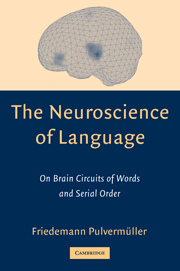Book contents
- Frontmatter
- Contents
- Preface
- The Neuroscience of Language
- 1 A Guide to the Book
- 2 Neuronal Structure and Function
- 3 From Classic Aphasia Research to Modern Neuroimaging
- 4 Words in the Brain
- Excursus E1 Explaining Neuropsychological Double Dissociations
- 5 Regulation, Overlap, and Web Tails
- 6 Neural Algorithms and Neural Networks
- 7 Basic Syntax
- 8 Synfire Chains as the Basis of Serial Order in the Brain
- 9 Sequence Detectors
- 10 Neuronal Grammar
- 11 Neuronal Grammar and Algorithms
- Excursus E2 Basic Bits of Neuronal Grammar
- Excursus E3 A Web Response to a Sentence
- 12 Refining Neuronal Grammar
- Excursus E4 Multiple Reverberation for Resolving Lexical Ambiguity
- Excursus E5 Multiple Reverberations and Multiple Center Embeddings
- 13 Neurophysiology of Syntax
- 14 Linguistics and the Brain
- References
- Abbreviations
- Author Index
- Subject Index
5 - Regulation, Overlap, and Web Tails
Published online by Cambridge University Press: 15 December 2009
- Frontmatter
- Contents
- Preface
- The Neuroscience of Language
- 1 A Guide to the Book
- 2 Neuronal Structure and Function
- 3 From Classic Aphasia Research to Modern Neuroimaging
- 4 Words in the Brain
- Excursus E1 Explaining Neuropsychological Double Dissociations
- 5 Regulation, Overlap, and Web Tails
- 6 Neural Algorithms and Neural Networks
- 7 Basic Syntax
- 8 Synfire Chains as the Basis of Serial Order in the Brain
- 9 Sequence Detectors
- 10 Neuronal Grammar
- 11 Neuronal Grammar and Algorithms
- Excursus E2 Basic Bits of Neuronal Grammar
- Excursus E3 A Web Response to a Sentence
- 12 Refining Neuronal Grammar
- Excursus E4 Multiple Reverberation for Resolving Lexical Ambiguity
- Excursus E5 Multiple Reverberations and Multiple Center Embeddings
- 13 Neurophysiology of Syntax
- 14 Linguistics and the Brain
- References
- Abbreviations
- Author Index
- Subject Index
Summary
Chapter 4 offers a neurobiological perspective on word processing in the brain. The time course and topography of cortical activation during word processing, in particular during the processing of words of different categories, is discussed in some detail. The proposal is that there is a cell ensemble or functional web for each and every word, and that words with different referential meaning may have functional webs characterized by different topographies.
Looking at words more closely, more questions arise, for example, regarding complex form–meaning relationship. Two words may share their form (e.g., “plane,” meaning “aircraft” or “flat surface”), or may sound differently but have largely the same meaning (e.g., “car” and “automobile”). There are word forms that include other word forms (e.g., the letter sequence “nor,” including “no” and “or”), and there are words whose meaning includes, so to speak, the meaning of others (e.g., “animal” and “dog”). These relationships of homophony (or polysemy), homonymy (or synonymy), inclusion of word forms in other word forms, and hyperonymy (vs. hyponymy) may pose problems to an approach relying on cortical neuron webs. How might a neurobiologically realistic model of complex form-meaning relationships look? Tentative answers are discussed in the section on overlap of representations.
Other aspects largely ignored in earlier chapters relate to the information about written language and to aspects of meaning that have been characterized as emotional or affective.
- Type
- Chapter
- Information
- The Neuroscience of LanguageOn Brain Circuits of Words and Serial Order, pp. 74 - 95Publisher: Cambridge University PressPrint publication year: 2003



